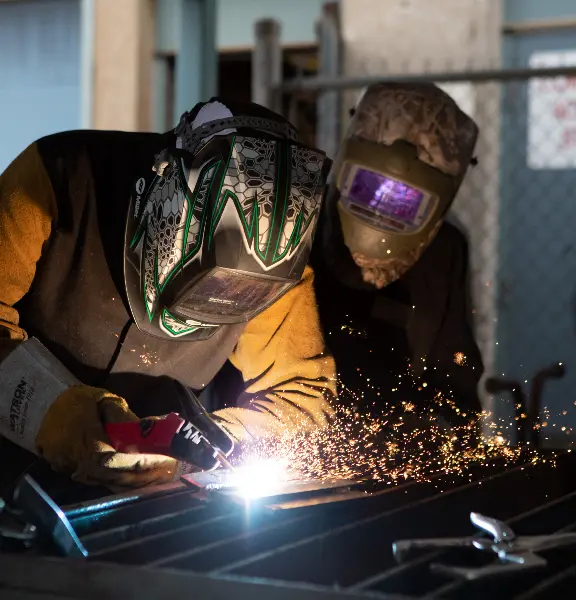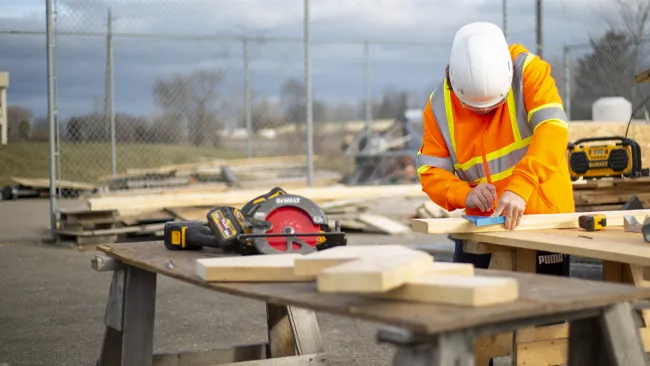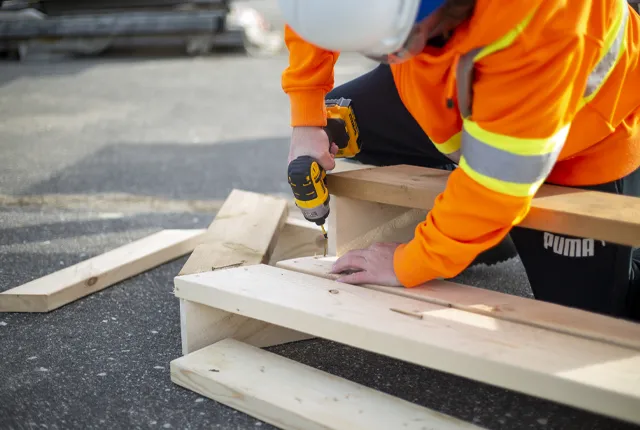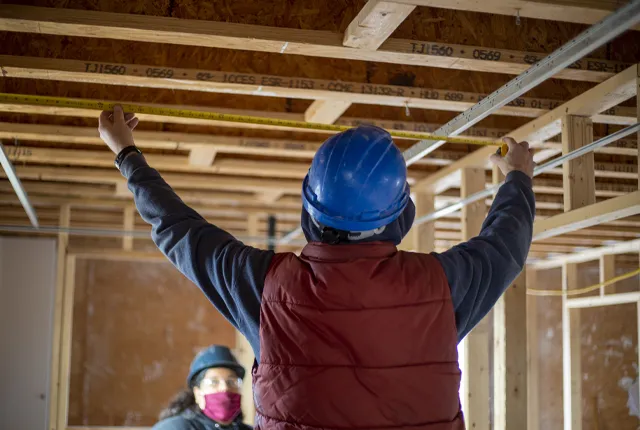A General Carpenter constructs, renovates, and repairs structures made of wood, steel, concrete, and other materials in the residential, commercial, and industrial construction sectors and in related industries.
This apprenticeship program follows the current curriculum as set by Skilled Trades Ontario.
Students who have graduated from the Renovation Construction Technician program will be exempt from taking the basic level of this apprenticeship program, while also increasing the chances of obtaining a sponsor for a Carpenter Apprenticeship.

Training
The General Carpenter apprenticeship program consists of on-the-job and in-school training. The program typically takes four years to complete and consists of:
- 7,280 hours of on-the-job training and work experience
- 720 hours of in-school training
Red Seal Exam
At the completion of the in-school portion of the apprenticeship, graduates are given a week of preparation before they write the Red Seal exam for the trade.
Our students may write this exam at the College at the end of the training, or book a separate time to write the exam at the MLTSD office.
What do Carpenters do?
Admission Requirements
- O.S.S.D. or equivalent
Application Process
This is an apprenticeship program and follows a different application process than regular post-secondary education programs. You cannot apply to this program through ontariocolleges.ca.
Applicants who are registered as an apprentice in a trade should receive a letter from the Ministry of Labour, Training & Skills Development inviting them to apply for schooling. All applications from that point will need their payment processed by the Office of the Registrar & Financial Aid Services at Lambton College.
If you are a registered apprentice and have not received a letter regarding apprenticeship school, please contact your local Ministry of Labour, Training & Skills Development office.

Training Dates
The following training dates are for the 2023-2024 academic year for the General Carpenter apprenticeship.
- Basic (CARB) Dates
- January 6, 2025 - February 28, 2025
- Intermediate (CARI) Dates
- October 28, 2024 - December 20, 2024
- March 3, 2025 - April 25, 2025
- Advanced (CARA) Dates
- August 26, 2024 - October 25, 2025
Course List
Rigging, Health & Safety
Upon successful completion the apprentice will be able to demonstrate and apply knowledge of proper basic hoisting and rigging procedures including hoisting and rigging hazards, fibre rope, knots and hitches, hardware, wire rope, slings, rigging tools and devices, and hazard awareness in crane operations.
Plans, Specifications, & Codes I
This course introduces the apprentice to the Ontario Building Code; how to use it, how to find needed information about joist sizes, rafter spacing, fire and electrical codes. The apprentice will learn to prepare basic geometric sketches and understand the different types of drawings, views, the alphabet of lines, notes and title blocks. This course introduces the apprentice to the skills required to read and interpret a set of blueprints.
Estimating, Calculations, & Layouts I
This course will develop the student's understanding of trade calculations and the ability to apply them to carpentry related problems. The student will start with a full review of basic arithmetic using whole numbers, fractions, and decimals. Geometric shapes, similar triangles and the Pythagorean Theorem are then covered in detail.
Metal Cutting & Welding
This course will introduce the carpenter apprentice to the basic principles and applications of safety, oxy-fuel cutting (OFC), Shielded Metal Arc Welding (SMAW) and the equipment for each. They will demonstrate basic cutting and welding for non-structural components (such as metal door frame, anchor bolts, rebar, etc) to the curriculum standards.
Hand Tools, Wood & Materials
This course presents material relating to the carpentry/joinery trades and the different types of work available in these trades. The apprentice acquires knowledge about the history of the trade and new technologies emerging in the construction industry. The apprentice is introduced to a variety of materials used in the building trade, and on the care and use of hand tools. The student will construct projects which will enable them to develop expertise in the use of hand tools and materials.
Power Tools, Joints & Fasteners
Upon successful completion the apprentice will be able to identify, select, maintain and use portable and stationary power tools. Power tool safety will be a main topic using the highest standard. Battery powered and pneumatic powered tools are examined and used as well as powder actuated tool safety. The apprentice will also be able to identify all common wood joints and be able to make woodworking joints using power tool. Fasteners and adhesives common in the carpentry trade are examined and many are used when building shop projects.
Interior & Exterior Finish
This course presents material which provides the apprentice with the ability to describe and construct the elements found in residential construction. The apprentice acquires knowledge about: installation of interior doors, casing, baseboards, chair rail, crown moulding, cabinets and vanities, wall finishes, flooring, exterior windows and doors, cladding, cornice finish, flashings, and shingles.
Plans, Specifications & Codes II
This course presents material which will enable the apprentice to develop skill in the reading, interpreting and drawing of residential plans knowing the specifications and provincial codes for housing.
Estimating, Calculations & Layouts II
This course will further develop the student's understanding of trade calculations and the ability to apply them to carpentry related problems. At first, a full review is done concentrating on Pythagorean Theorem and similar triangles. The apprentice will then study percent, percentages and progress to estimating linear, area and volume quantities using direct and computed measurement and finally work with more advanced powers and roots.
Foundations, Floors & Walls
This course presents material which provides the apprentice with the ability to describe and construct the elements found in residential construction. The apprentice acquires knowledge about: building layout, excavation, footing and foundations, tile drainage, installation of sill plates, installation of floor beams, columns, joists, exterior wall framing, structural and non-structural sheathing, interior walls, and the installation of insulation.
Ceilings & Roofs
This course presents material which provides the apprentice with the ability to describe and construct the elements found in residential construction. The apprentice acquires knowledge about: the function and installation of ceiling joists, the layout, cutting, and installation of different types of equal and unequal slope roofs, and describe and install roof truss systems.
Commercial Plans, Specifications & Codes
Through this course the apprentice gains the working knowledge and skill in the reading and interpretation of commercial plans, specifications, and codes.
Estimating, Calculations & Layouts III
This course presents material which will enable the apprentice to develop skill in estimating material quantities and costs for commercial plans.
Levels & Transits
This course presents material which will enable the apprentice to develop knowledge and skill to establish level points and elevations using a builder's level and a laser level. The apprentice will also be able to establish building layout points using a transit / theodolite and competently use various forms of degree measurements for angles.
Formwork
This course presents material which will enable the apprentice to develop knowledge and skill in the layout and construction of concrete formwork used in commercial construction. The apprentice will also be able to layout and construct commercial footing forms as well as be able to work safely when shoring and excavating.
Stairs & Commercial Finishing
Upon successful completion the apprentice will be able to calculate, layout, cut, and assemble stairs and ramps.
Commercial Finishing
Upon successful completion the apprentice will be able to demonstrate knowledge and skill in the installation of suspended ceiling systems, metal studs, demountable partitions, and commercial hardware. The apprentice will also be able to recognize types of commercial exterior finishes.
Carpentry Pre-Exam

This Employment Ontario program is funded in part by the Government of Canada and the Government of Ontario.
Contact Us
Applied Science, Engineering Technology & Trades





